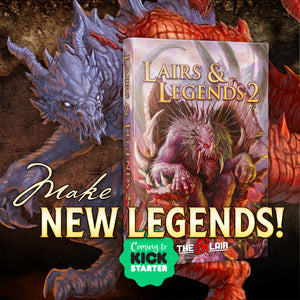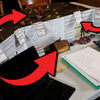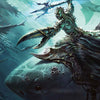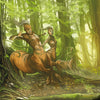How to Reward Magic Items in D&D
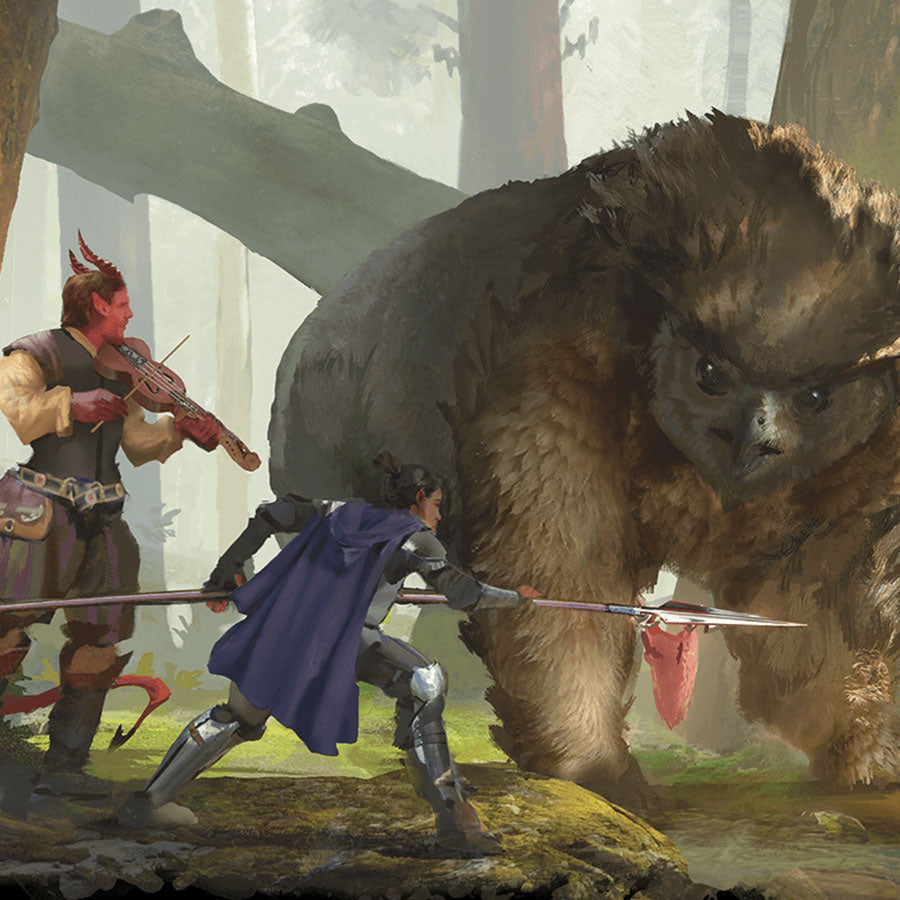
By Luke Hart
Today in the Lair, we’ll be discussing 10 strategies for rewarding magic items in D&D without breaking the game. That is, how to give your players’ characters magic items in a way that doesn’t result in the game becoming unbalanced insomuch that enemies and encounters are trivial and get steamrolled with ease.
By the way, are you a NEW GAME MASTER feeling a bit overwhelmed by everything involved with running a role-playing game? If so, the Secret Art of Game Mastery can help. Get over 100 years of GM experience distilled into practical, easy-to-read advice.
Watch or listen to this article by clicking the video below.
1. At low levels be frugal with magic items and at higher levels be more generous.
Over the course of several years of running four simultaneous 5e campaigns, and until recently two games a week, I have found that magic items are most game breaking at low levels but not so much at higher levels. At higher levels, character abilities become very powerful and magic items have less of an influence on things. You’ll also find that the ATTUNEMENT mechanic starts coming into play at mid to high levels, effectively limiting how powerful a group’s magic item cache is. Having lots of cool magic items is only so powerful when half of them can’t be used due to the limitations of only being able to attune to three magic items at a time.
So, my advice is to reward fewer magic items at lower levels than the core rule books suggest you do, and then once your players start to reach higher levels, say level 8, start to ratchet things up. By level 8, magic items become less influential on the game, as long as you don’t go NUTS and give out way too many OR starting giving out very rare and legendary magic items too soon. If you decide loose cannon on me and revert back to giving magic items out like candy and at high rarities, none of my advice can really help you.
Now, if you want to know EXACTLY how many magic items to reward, Xanathar’s Guide to Everything does give specific numbers of magic items to reward, of which rarity, and at which levels. I suggest cutting those numbers IN HALF as a starting point and then see how things go. You can always ratchet things up later if needed.
2. Ignore the Magic Item Rarity Table in the Dungeon Master Guide
On page 135 in the DMG there is a Magic Item Rarity table that supposedly tells you at which levels characters might begin to find magic items of certain rarities. I strongly suggest you IGNORE that table and go with the recommendations I’m about to give you. Here’s the thing, when the DMG was first written, 5th edition had just come out. The game was young. It hadn’t been played or even play tested a whole lot. The game developers were under pressure from the suits in the C suite to wrap things up and ship the game out the door. AND that table has NOT been revisited at all over the years to account for more powerful player options that have come out in splat books. So by this point, it just far less useful than it even was when the game first came out.
This is my recommendation for when you should give out certain magic item rarities in your game.
· Begin rewarding common magic items at level 2.
· Begin rewarding uncommon magic items at level 4.
· Begin rewarding rare magic items at levels 7.
· Very rare at levels 11.
· Legendary at levels 17.
This will start your characters out on a slow roll with less powerful magic items at lower levels when they are most impactful, and then more powerful ones at higher levels when they are still very useful, but not as crazy game altering.
3. Err on the side of giving out TOO FEW magic items.
You can always give more later; it’s exceedingly hard/impossible to take them back.
There is a popular theory going around, promulgated by certain sweaty-toothed madmen, that you should give out magic items to your players right away and like candy because magic items are cool and you don’t know how long the campaign might even last.
Consequently, a common question I get on my live streams is “Luke, help! I gave my party too many magic items, now they are super powerful and steamrolling the module, and I don’t know what to do.” My response is usually, “Well you screwed yourself over on that one didn’t you?” Actually I’ll tell them they have TWO choices: 1) Live with it. Suck it up. You screwed up and gave your players too many magic items. Done is done. Now go through and adjust the difficulty of your campaign or ALL the encounters in the module. 2) Confess to your players that you screwed up and gave them too many magic items and that it’s breaking the game and causing you loads of extra work. Ask them nicely if they might be okay with giving some of the magic items back OR adjusting them to make them less powerful. And GOOD LUCK. This will feel like a nerf to players, and many players don’t like that.
If you give out fewer magic items than the DMG or Xanathar’s recommends, EVERYTHING WILL BE OKAY. The rules are actually balanced for ZERO MAGIC ITEMS and most groups will do just fine with NO MAGIC ITEMS WHATSOEVER. Don’t believe me? Look at the “Are magic items necessary in a campaign?” sidebar on page 136 of Xanathar’s Guide to Everything. It literally explains that characters and monsters in D&D 5th edition are balanced such that PCs do NOT need magic items to keep up with the power curve—except in very rare instances, which rarely happen. In fact, I would argue that with the new character options coming out in books like Tasha’s—character options that are more and more crazy powerful—magic items are less necessary than they were before. The truth is that 5th edition characters are super powerful all by themselves. They don’t need magic items coming out for their ears on top of things.
So, give out magic items sparingly, and then every couple levels of play, take an inventory of what everyone has, and see if some more magic items should be given out. Players do like magic items, so you don’t want to cut them off completely. Just don’t be a moron and give them out like candy UNLESS you are a veteran dungeon master and know how to handle the resulting power imbalance.
4. Beware of magic items that CLAIM to be uncommon, but are actually far more powerful.
For example, winged boots are NOT uncommon; they are very rare in my book. They essentially give you unlimited flying during an adventure due to how the magic item is worded. However, Wings of Flying, listed right below winged boots are significantly LESS powerful; giving you less flying time. I don’t know what folks are smoking at times.
The fact is, many uncommon wondrous magic items are more powerful than they may seem due to creative ways that players use them. You learn this from experience or from reading up on them on the internet.
And the more you play the game, the more you realize that item rarity actually doesn’t seem to correlate too well with how powerful a magic item is. It should, according to how the DMG describes rarity, but in actual game play, it really doesn’t. Now you can chalk this up to a lack of playtesting or a failure to incorporate playtesting results into the alpha and beta drafts of the rules. You might point out that game developers play the game far less than they probably should. You might blame the suits for making changes and poking at things they know nothing about. But at the end of the day, the fact of the matter is that you can’t trust rarity as a judge of an item’s power.
As I was researching this topic, I stumbled upon a very useful article online called Sane Magic Item Prices (link below). Basically lots of people had a big discussion about relative magic item power and then priced them out with the least powerful items being worth the least gold and the most powerful items being worth the most gold. Now, I’m not suggesting you necessary SELL magic items or even use the gold pieces they listed as an indicator of what a magic item might sell for. The primary usefulness of what they did, IMO, is that they ORDERED the power of the various magic items in the DMG based on gp prices. So, you can at a glance see the RELATIVE power of the various magic items. And this is super super helpful for dungeon masters, especially new ones.
5. Change how attunement works!
Since attunement is a limiting factor in how many magic items that require attunement a PC can use at any given time – and since magic items that require attunement are often far more powerful than ones that DON’T require attunement – changing some of the rules around attunement can be useful to us.
In the rules as written, any given character can attune to THREE magic items at a time. And attuning to a magic item that requires attunement takes a SHORT REST which lasts ONE HOUR and can’t be interrupted, otherwise the attunement process must begin again. Also, unattuning from an item requires a short rest. So, if a character is maxed out at 3 attuned items and wants to swap out an item for another, it takes TWO short rests: one to unattuned an item; a second to attune to the new item.
The first rule we can change is HOW MANY magic items a character can be attuned to at a time. And I suggest changing this to an increasing scale whereby at low levels PCs can be attuned to FEWER items and then as they gain levels, it increments. Specifically I would do this:
· At first level, a PC cannot attune to any magic items at all. So they are limited to using magic items that do NOT require attunement. And there are lots of common and uncommon magic items that don’t require attunement, so no worries.
· At 3rd level, a PC gains the ability to attune to ONE magic item at a time.
· At 6th level, a PC can now attune to TWO magic items at once.
· At 9th level, a PC can attune to THREE magic items at once. And then stop there. Never let them attune to more than three magic items.
Doing this allows you to perhaps give out magic items a little more readily if you want to – as long as they require attunement – but limits the PCs in how many they can use in the lower levels. And then once they get into the higher levels where magic item power is less of a factor in game balance, they can attune to three magic items per the core rules.
The next rule you could tweak is that for how long attuning to a magic item takes. Instead of a short rest, you could say it takes a LONG REST to attune to a magic item. And if you did this, I would say that over the course of a long rest, a PC could both unattuned from a magic item and attune to a new magic item. What this does is limit PC power a bit by making the cost of swapping attuned magic items higher and something they probably can’t do in the middle of delving a dungeon.
Finally, if you REALLY want to limit the amount of magic items PCs can use in your game, you could make it so that ALL magic item require attunement. That way any given character could only use up to three magic items at a time. And you could use the previous two rule tweaks as well to limit things even more. I’m not sure I recommend going this overboard crazy with limiting how many magic items PCs can use. These rule changes are fairly heavy handed, though they could be okay for certain campaigns, especially a campaign that the dungeon master is specifically billing as LOW MAGIC. For campaigns like that, they could be very appropriate.
6. Ignore how experienced dungeon masters reward magic items in their games!
So you like watching Critical Role and other D&D shows run by professional game masters who often have tons of experience? Awesome. Me, too. Those shows are often very entertaining and fun to watch. However, don’t check your brain at the door. Recognize two things: First, those are experienced dungeon masters. What works for them and what THEY know how to do won’t necessarily work for you, especially if you are an inexperienced game master. Second, they are running a D&D show whose primary objective is entertainment value for the viewers. How they do things should be taken with a large grain of salt for dungeon masters who are running D&D GAMES and not D&D SHOWS. Because there is a difference. A big difference.
Now, this piece of advice actually applies to almost EVERYTHING professional dungeon masters do, which means that it also applies to rewarding magic items. So, your favorite dungeon master claims in his videos that he loves giving out tons of magic items to his players does he? That’s great. FOR HIM. He’s experienced. He knows what it means to his game for the PCs to be even more powerful, and he knows how to balance encounters appropriately as a result. But if you’re an inexperienced or new dungeon master, do YOU know how to do that? If not, you’d better think twice about doling out crap tons of magic items like he does.
The same thing applies to advice you may find on the internet or the advice from us talking head YouTubers. Just because I say I do a thing or another video advice guy says he does a thing does NOT mean you should do that same thing. Evaluate all advice through the filter of your own experience and knowledge. Also consider if the person is giving advice to new DMs or experienced DMs. Or if the person is just saying “This is what I do.” An experienced DM saying “This is what I do.” Is probably less helpful for new DMs, unless the person says it will work for them, too.
7. Reward more consumable and rechargeable magic items!
You can still have a game full of magic items; you can still be generous with magic items, even at low levels, when you give out CONSUMABLE, single-use magic items such as potions and scrolls. Because it can only be used ONCE, its power is very limited, and cannot by definition be permanently game breaking, though it could influence one specific encounter, of course. You can also take more powerful magic items like WANDS and instead of having them regain all their charges at dawn each day, you can say they have a fixed number of charges and when they are all used up, they are gone.
You can also make magic items rechargeable! Basically, you could take any magic item and put a cap on how long its magic functions for any given day. That belt of giant strength: well, it only works three times per day for 1 minute each time. Efreeti chain: same. It only works a certain number of times per day for a limited duration each use. And then it must recharge. Many magic items ALREADY work this way, so you can add a little homebrew to others to make them have a similar functionality, thus allowing you to reward them without them having as powerful effect on game balance.
You can also add a game mechanic for recharging those magic items. So, take wands. They don’t AUTOMATICALLY recharge every day at dawn, but a wizard could expend 3rd level spell slots to recharge a wand of lightning. For every 3rd level spell slot they expend, the wand regains 1 charge. Efreeti chain could be recharged by casting fireball into it, or by submerging it in flowing lava. A belt of giant strength could be recharged by casting enlarge into it, or by filling up a reservoir in the belt’s buckle with a large lock of giant’s hair – that the characters must somehow procure. You can use your creativity to make this recharge mechanic pretty interesting and cool.
8. Use magic items that gain power as the character level.
There are a couple ways you can do this. First, you can give the characters personalized magic items that are intended to grow in power as the PCs grow in power. So at level 3 the magic sword doesn’t do much at all. At level 6 it becomes +1. At level 9 the user gains resistance to fire damage. At level 12 the user can cast fireball three times per day. At level 15 the sword becomes a +3 sword. At level 17, the user can cast wall of fire three times per day. That’s just one example. Use your creativity to come up with mechanics like that for magic items you give your players. Just bear in mind that if you do this, the PCs should get far FEWER magic items because those they do get will gain power as they level up. You might even consider enlisting your players’ help in designing these custom magic items that power up. Find out what THEY want to be able to do and give them a say in designing the magic item’s features. Does this take some of the mystery and awe out of the game for them? Yes, it sure would, because they know everything the magic item will eventually be able to do. So, I personally probably wouldn’t do that – it ruins a bit of the fun for them, IMO – but it is an option.
Next you can have magic items be “depowered.” That is, they’ve lost some of their magical power and they must be powered back up through some game mechanic that you determine. So, those boots of flying right now can only help the PC jump twice as far or twice as high. But if the characters go on a quest to the mountain of Yundofar and obtain a feather of a roc, they can have a local wizard use that feather to imbue magical flying into the boots. However, the boots still only give a very limited amount of flying, and another quest would be needed to power them up more. Now, before you get all hyped up on this idea, let me give you a MASSIVE WORD OF WARNING. Doing this could easily cause your entire D&D campaign to become nothing more than quest after quest of the characters just trying to level up their magic items. So that module you were running? Yeah, forget about that. All your PCs care about now is powering up the magic items you gave them. This is an example of something that looks GREAT on paper, but in actual practice might not work so well – at least not if you do it for lots of magic items. It would work GREAT for one magic item in the game, especially if the magic item is important to the main plot line and must be powered up in order for the group to defeat the final villain. If used for something like that, it could be super cool.
9. Reward magic items with more flavor than power.
Just because you’re giving your players magic items doesn’t mean they have to be super powerful! You can easily give them strange and exotic magic items that have lots of FLAVOR and backstory, and even do something cool and interesting, but that doesn’t have much use in COMBAT or contributes very little to combat. A bag of holding falls into this category, as do paper birds. Okay, you can now carry bunches of stuff and not worry about inventory management. Yay. Okay, you can send messages over long distances. That’s useful and fun, but doesn’t require the game master to beef up the combats one bit. You can also design homebrew magic items with minor magical abilities but with lots of HISTORY and backstory that ties into your game world or the campaign. Things can be cool without having to be powerful. And this allows you to reveal interesting bits of LORE about your world or the campaign plot in a unique way – as opposed to information dumps by NPCs, for instance.
10. Just Beef Up the Game!
Let’s be honest here, making the encounters more challenging is NOT THAT HARD. So, you can be generous with magic items, ignore everything I just said, and then add an additional monster or two to encounters if the PCs are particularly powerful due to magic items. You can increase the monster HPs or, even better, increase their damage output by giving them an additional attack. These are super simple and quick adjustments that you can make to the game, even to pre-made modules that you are running. This isn’t brain surgery. It literally takes seconds to do, and you can even do it on the fly during the game.
Now, many people will tell you that instead of just increasing monsters’ stats (like hit points and DPS) or increasing the number of monsters that what you SHOULD do is make the monsters fight more intelligently. And this does AS LONG AS YOU KNOW HOW TO DO THIS, though I will argue that it is much harder to do in actual practice than it is to tell you to do it. Not only is this more challenging to pull off than simply increasing the number of monsters or beefing their hit points or damage output, most new dungeon masters DON’T know how to do this, so that sort of advice is not very useful to many DMs. However, if you do want to learn how to make monsters fight more intelligently there are two ways to do it: 1) Years of experience, or 2) read The Monsters Know What They Are Doing by Keith Ammann. You can get the book off Amazon, or you can read his blog. Both are excellent and will help you learn how to have your enemies fight more tactfully in combat.
100 Years of GM Experience at Your Fingertips!
Are you a NEW GAME MASTER feeling a bit overwhelmed by everything involved with running a role-playing game? Are you a VETERAN GAME MASTER looking for new tips and tricks to take your games to the next level? Look no further than the Secret Art of Game Mastery.
We at the DM Lair have distilled our CENTURY of accumulated GM experience into an easy-to-read guide of practical advice that you can immediately apply to your games! We've even included our own templates–the things that we use to prepare our ACTUAL games.
Get all three books to master your game:
- The Secret Art of Game Mastery. Contains over 100 years of GM advice distilled into an easy-to-read format. It introduces and explains the tools of the trade, scheduling, playstyle, post-game notes, getting player feedback, and more.
- The Secret Art of Preparation. Brings to your fingertips the actual templates and guides that the DM Lair team uses to prepare games, Lair Magazine, and more. Designed as a three-ring binder, it's intended for you to write directly into for your entire campaign!
- The Secret Art of Notetaking. Gives you the keys to tracking your campaign from session to session just like the DM Lair team. Designed as a three-ring binder, it's intended for you to write in and keep track of your whole campaign!
With so much knowledge and experience on its pages, The Secret Art of Game Mastery is guaranteed to become an indispensable tool for all game masters, new and veteran alike. And if that isn’t enough, the information applies to all game systems and all genres!
-
Posted in
Game Master How-To Articles



